初中英语优秀经典说课稿_思路清晰_模版经典_绝对超值
- 格式:ppt
- 大小:3.97 MB
- 文档页数:23
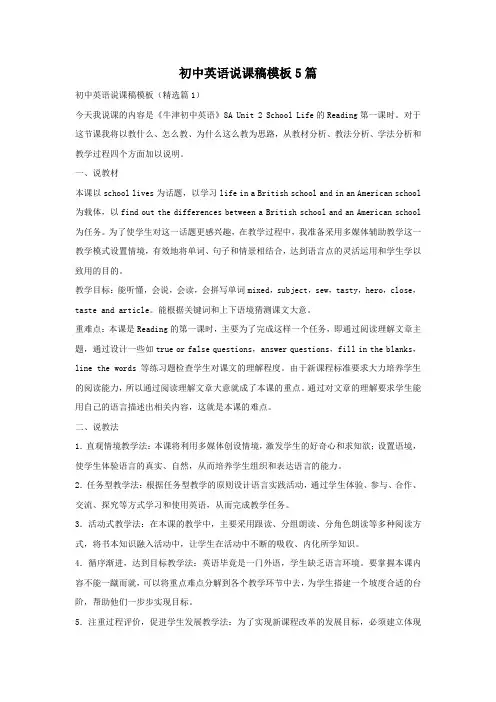
初中英语说课稿模板5篇初中英语说课稿模板(精选篇1)今天我说课的内容是《牛津初中英语》8A Unit 2 School Life的Reading第一课时。
对于这节课我将以教什么、怎么教、为什么这么教为思路,从教材分析、教法分析、学法分析和教学过程四个方面加以说明。
一、说教材本课以school lives为话题,以学习life in a British school and in an American school 为载体,以find out the differences between a British school and an American school 为任务。
为了使学生对这一话题更感兴趣,在教学过程中,我准备采用多媒体辅助教学这一教学模式设置情境,有效地将单词、句子和情景相结合,达到语言点的灵活运用和学生学以致用的目的。
教学目标:能听懂,会说,会读,会拼写单词mixed,subject,sew,tasty,hero,close,taste and article。
能根据关键词和上下语境猜测课文大意。
重难点:本课是Reading的第一课时,主要为了完成这样一个任务,即通过阅读理解文章主题,通过设计一些如true or false questions,answer questions,fill in the blanks,line the words等练习题检查学生对课文的理解程度。
由于新课程标准要求大力培养学生的阅读能力,所以通过阅读理解文章大意就成了本课的重点。
通过对文章的理解要求学生能用自己的语言描述出相关内容,这就是本课的难点。
二、说教法1.直观情境教学法:本课将利用多媒体创设情境,激发学生的好奇心和求知欲;设置语境,使学生体验语言的真实、自然,从而培养学生组织和表达语言的能力。
2.任务型教学法:根据任务型教学的原则设计语言实践活动,通过学生体验、参与、合作、交流、探究等方式学习和使用英语,从而完成教学任务。
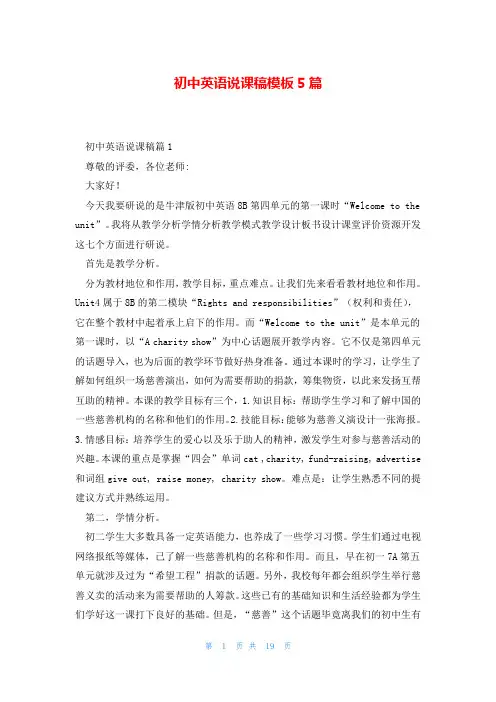
初中英语说课稿模板5篇初中英语说课稿篇1尊敬的评委,各位老师:大家好!今天我要研说的是牛津版初中英语8B第四单元的第一课时“Welcome to the unit”。
我将从教学分析学情分析教学模式教学设计板书设计课堂评价资源开发这七个方面进行研说。
首先是教学分析。
分为教材地位和作用,教学目标,重点难点。
让我们先来看看教材地位和作用。
Unit4属于8B的第二模块“Rights and responsibilities”(权利和责任),它在整个教材中起着承上启下的作用。
而“Welcome to the unit”是本单元的第一课时,以“A charity show”为中心话题展开教学内容。
它不仅是第四单元的话题导入,也为后面的教学环节做好热身准备。
通过本课时的学习,让学生了解如何组织一场慈善演出,如何为需要帮助的捐款,筹集物资,以此来发扬互帮互助的精神。
本课的教学目标有三个,1.知识目标:帮助学生学习和了解中国的一些慈善机构的名称和他们的作用。
2.技能目标:能够为慈善义演设计一张海报。
3.情感目标:培养学生的爱心以及乐于助人的精神,激发学生对参与慈善活动的兴趣。
本课的重点是掌握“四会”单词cat ,charity, fund-raising, advertise 和词组give out, raise money, charity show。
难点是:让学生熟悉不同的提建议方式并熟练运用。
第二,学情分析。
初二学生大多数具备一定英语能力,也养成了一些学习习惯。
学生们通过电视网络报纸等媒体,已了解一些慈善机构的名称和作用。
而且,早在初一7A第五单元就涉及过为“希望工程”捐款的话题。
另外,我校每年都会组织学生举行慈善义卖的活动来为需要帮助的人筹款。
这些已有的基础知识和生活经验都为学生们学好这一课打下良好的基础。
但是,“慈善”这个话题毕竟离我们的初中生有点遥远,有些学生会觉得陌生。
所以,老师在教学活动中必须创设适当的情境,针对不同层次的学生设计多样的教学任务,从而吸引学生们的兴趣,使他们积极主动投入到教学活动中来。
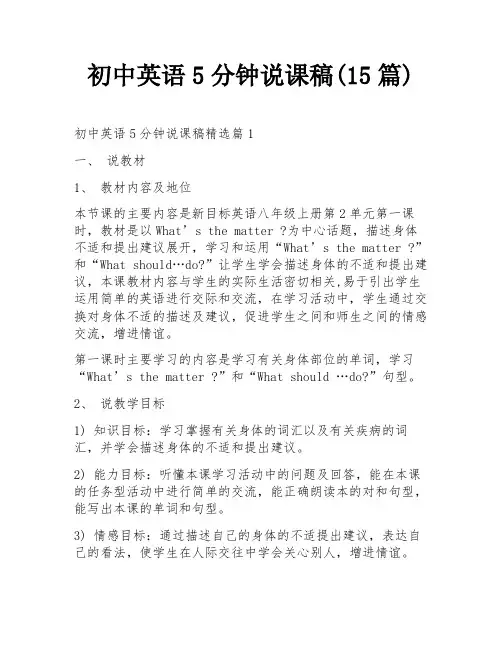
初中英语5分钟说课稿(15篇)初中英语5分钟说课稿精选篇1一、说教材1、教材内容及地位本节课的主要内容是新目标英语八年级上册第2单元第一课时,教材是以What’s the matter ?为中心话题,描述身体不适和提出建议展开,学习和运用“What’s the matter ?”和“What should…do?”让学生学会描述身体的不适和提出建议,本课教材内容与学生的实际生活密切相关,易于引出学生运用简单的英语进行交际和交流,在学习活动中,学生通过交换对身体不适的描述及建议,促进学生之间和师生之间的情感交流,增进情谊。
第一课时主要学习的内容是学习有关身体部位的单词,学习“What’s the matter ?”和“What should …do?”句型。
2、说教学目标1) 知识目标:学习掌握有关身体的词汇以及有关疾病的词汇,并学会描述身体的不适和提出建议。
2) 能力目标:听懂本课学习活动中的问题及回答,能在本课的任务型活动中进行简单的交流,能正确朗读本的对和句型,能写出本课的单词和句型。
3) 情感目标:通过描述自己的身体的不适提出建议,表达自己的看法,使学生在人际交往中学会关心别人,增进情谊。
4) 文化意识目标:用恰当的方式表达自己的看法,增进人际交往中学会关心别人的能力,了解英美国家询问和表达身体不适的习惯,培养世界意识。
3、说教学重难点重点:本节课主要学习身体部位的单词和一些疾病的词汇,以及身体不适的表达及建议。
难点:身体不适的表达及建议二、说学情初二年级的学生对英语已经有了一定的基础,但本地区部分学生对学习英语的兴趣不是很浓,在学习中,他们更喜欢从游戏中或活动中学习,这样更能提高他们的学习兴趣,让他们更轻松地掌握英语知识。
三、说教法作为教学的引导着,我遵循新课程“学生是学习的主人,一切的教学活动设计在以学生为本”的教学理念,坚持“为学生的发展,必须培养学生的自主性、能动性、独立性和创造性”的教学原则。
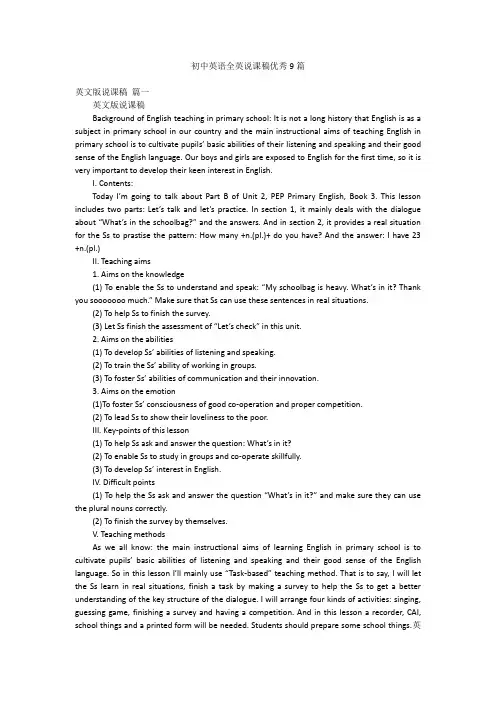
初中英语全英说课稿优秀9篇英文版说课稿篇一英文版说课稿Background of English teaching in primary school: It is not a long history that English is as a subject in primary school in our country and the main instructional aims of teaching English in primary school is to cultivate pupils’ basic abilities of their listening and speaking and their good sense of the English language. Our boys and girls are exposed to English for the first time, so it is very important to develop their keen interest in English.I. Contents:Today I’m going to talk about Part B of Unit 2, PEP Primary English, Book 3. This lesson includes two parts: Let’s talk and let’s practice. In section 1, it mainly deals with the dialogue about “What’s in the schoolbag?” and the answers. And in section 2, it provides a real situation for the Ss to prastise the pattern: How many +n.(pl.)+ do you have? And the answer: I have 23 +n.(pl.)II. Teaching aims1. Aims on the knowledge(1) To enable the Ss to understand and speak: “My schoolbag is heavy. What’s in it? Thank you sooooooo much.” Make sure that Ss can use these sentences in real situations.(2) To help Ss to finish the survey.(3) Let Ss finish the assessment of “Let’s check” in this unit.2. Aims on the abilities(1) To develop Ss’ abilities of listening and speaking.(2) To train the Ss’ ability of working in groups.(3) To foster Ss’ abilities of communication and their innovation.3. Aims on the emotion(1)To foster Ss’ consciousness of good co-operation and proper competition.(2) To lead Ss to show their loveliness to the poor.III. Key-points of this lesson(1) To help Ss ask and answer the question: What’s in it?(2) To enable Ss to study in groups and co-operate skillfully.(3) To develop Ss’ interest in English.IV. Difficult points(1) To help the Ss ask and answer the question “What’s in it?” and make sure they can use the plural nouns correctly.(2) To finish the survey by themselves.V. Teaching methodsAs we all know: the main instructional aims of learning English in primary school is to cultivate pupils’ basic abilities of listening and speaking and their good sense of the English language. So in this lesson I’ll mainly use “Task-based” teaching method. That is to say, I will let the Ss learn in real situations, finish a task by making a survey to help the Ss to get a better understanding of the key structure of the dialogue. I will arrange four kinds of activities: singing, guessing game, finishing a survey and having a competition. And in this lesson a recorder, CAI, school things and a printed form will be needed. Students should prepare some school things.英文版英语说课稿VI. Teaching procedures and purposes of my designing.I’ll finish this lesson in five steps.Step 1. Warm-up and preview1. Free talk between T and Ss about things in the classroom.2. Sing the song together: Books and pencils.3. Do some TPR, for example: Show me your English book. Show me your crayon.4. Review the numbers by asking: “How many crayons do you have?”Purpose: It is important to form a better English learning surrounding for the Ss by singing and doing some total physical response and at the same time it provides situations to review learned knowledge for the next step.Step 2. PresentationNow I’ll mainly talk about this step.1. Present the pattern: “My schoolbag is heavy.” “What’s in it?.”(1) Show a bag and say: “Look! I have a bag.” Carry it and say: “Oh, it is heavy. My schoolbag is heavy.” Help the Ss understand the meaning with the help of my body language. Then lead the Ss to read the sentence. Make sure they can say it correctly.(2) T: My schoolbag is heavy.Open the bag and say: “What’s in it? What’s in my schoolbag?”Take out a Chinese book. Then do the action again. Let the Ss read the sentence.2. Play a guessing game. Divide the whole class into four groups to have a competition.Let them guess: What’s in the bag? How many? Purpose: To present the key structures one by one is much easier for the Ss to learn and grasp the meanings. Proper competition can arouse the Ss’ interest in English learning.3. With the help of the CAI to present the dialogue. Set a situation to help Ss understand: Two Ss are coming. One girl is carrying a heavy bag on her back. They are talking.Girl: My schoolbag is heavy.Boy: What’s in it?Girl: 20 story-books, 32 pencil, 9 rulers, 12 crayons and 30 picture-books. Etc.Boy: What will you do?Girl: They are for the poor.Boy: Great! I’ll bring some school things too.The boy comes back home and puts a lot of things into the bag. Then he goes to school again and gives them to a teacher. While he is taking them out, he is counting the numbers of all things. The teacher says: Thank you soooooooo much.4. Mention that we should take care of the poor.5. Play the cassette. Let the Ss listen and imitate the dialogue.Pay attention to their pronunciation and intonation. Purpose: CAI can provide a real situation for the Ss to understand the dialogue and the relationships between people better. Tell the Ss we should show our loveliness to the Ss.Step 3. PracticeDivide Ss into groups of six children. Each one would finish the printed form by asking and answering: How many storybooks do you have? Find out which group finishes faster. Story books picture-books sharpeners crayons pencils erasers pencil-cases rulers Chen Jie 8 24 3 32 26 4 1 3Purpose: Task-based teaching method is used here to develop Ss’ ability of communication and also their ability of co-operation will be well trained.Step 4. AssessmentHelp Ss finish “Let’s check” of this unit and workbook.Purpose: To check the knowledge Ss have learned in this period.Step 5. Add-activity1. Let Ss tell each other how many school things they have after class. Tell their parents how many school things they have at home.2. Take care of everything they have.Purpose: Revision is so important that Ss should speak English as much as they as in class or after class. It is necessary for the Ss to do some extensive exercises after class to consolidate the knowledge they learned.英文版英语说课稿初中英语说课稿篇二今天我的说课内容是新目标英语八年级上册第四单元第一课时。
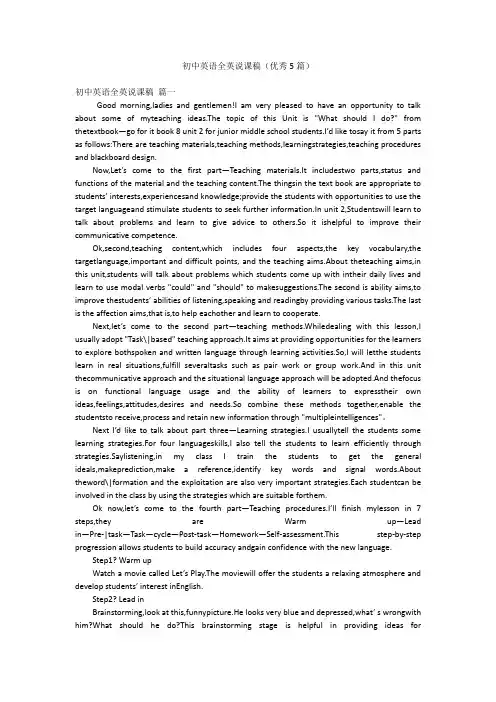
初中英语全英说课稿(优秀5篇)初中英语全英说课稿篇一Good morning,ladies and gentlemen!I am very pleased to have an opportunity to talk about some of myteaching ideas.The topic of this Unit is "What should I do?" from thetextbook—go for it book 8 unit 2 for junior middle school students.I’d like tosay it from 5 parts as follows:There are teaching materials,teaching methods,learningstrategies,teaching procedures and blackboard design.Now,Let’s come to the first part—Teaching materials.It includestwo parts,status and functions of the material and the teaching content.The thingsin the text book are appropriate to students’ interests,experiencesand knowledge;provide the students with opportunities to use the target languageand stimulate students to seek further information.In unit 2,Studentswill learn to talk about problems and learn to give advice to others.So it ishelpful to improve their communicative competence.Ok,second,teaching content,which includes four aspects,the key vocabulary,the targetlanguage,important and difficult points, and the teaching aims.About theteaching aims,in this unit,students will talk about problems which students come up with intheir daily lives and learn to use modal verbs "could" and "should" to makesuggestions.The second is ability aims,to improve thestudents’ abilities of listening,speaking and readingby providing various tasks.The last is the affection aims,that is,to help eachother and learn to cooperate.Next,let’s come to the second part—teaching methods.Whiledealing with this lesson,I usually adopt "Task\|based" teaching approach.It aims at providing opportunities for the learners to explore bothspoken and written language through learning activities.So,I will letthe students learn in real situations,fulfill severaltasks such as pair work or group work.And in this unit thecommunicative approach and the situational language approach will be adopted.And thefocus is on functional language usage and the ability of learners to expresstheir own ideas,feelings,attitudes,desires and needs.So combine these methods together,enable the studentsto receive,process and retain new information through "multipleintelligences"。
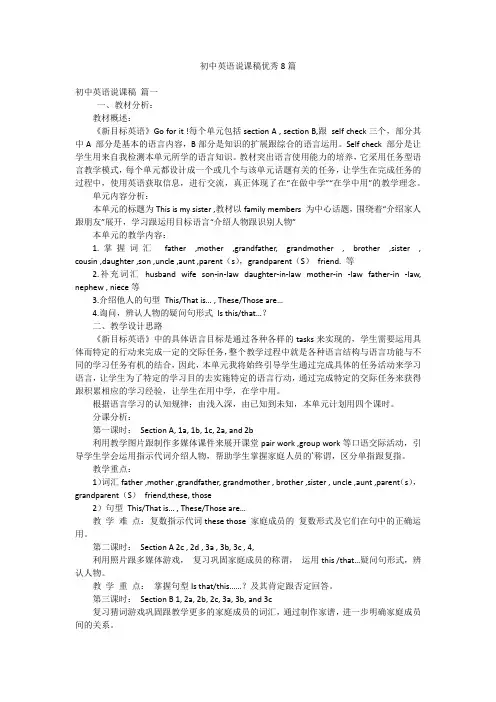
初中英语说课稿优秀8篇初中英语说课稿篇一一、教材分析:教材概述:《新目标英语》Go for it !每个单元包括section A , section B,跟self check三个,部分其中A 部分是基本的语言内容,B部分是知识的扩展跟综合的语言运用。
Self check 部分是让学生用来自我检测本单元所学的语言知识。
教材突出语言使用能力的培养,它采用任务型语言教学模式,每个单元都设计成一个或几个与该单元话题有关的任务,让学生在完成任务的过程中,使用英语获取信息,进行交流,真正体现了在“在做中学”“在学中用”的教学理念。
单元内容分析:本单元的标题为This is my sister ,教材以family members 为中心话题,围绕着“介绍家人跟朋友”展开,学习跟运用目标语言“介绍人物跟识别人物”本单元的教学内容:1.掌握词汇father ,mother ,grandfather, grandmother , brother ,sister , cousin ,daughter ,son ,uncle ,aunt ,parent(s),grandparent(S)friend. 等2.补充词汇husband wife son-in-law daughter-in-law mother-in -law father-in -law, nephew , niece等3.介绍他人的句型This/That is… , These/Those are…4.询问,辨认人物的疑问句形式Is this/that…?二、教学设计思路《新目标英语》中的具体语言目标是通过各种各样的tasks来实现的,学生需要运用具体而特定的行动来完成一定的交际任务,整个教学过程中就是各种语言结构与语言功能与不同的学习任务有机的结合,因此,本单元我将始终引导学生通过完成具体的任务活动来学习语言,让学生为了特定的学习目的去实施特定的语言行动,通过完成特定的交际任务来获得跟积累相应的学习经验,让学生在用中学,在学中用。
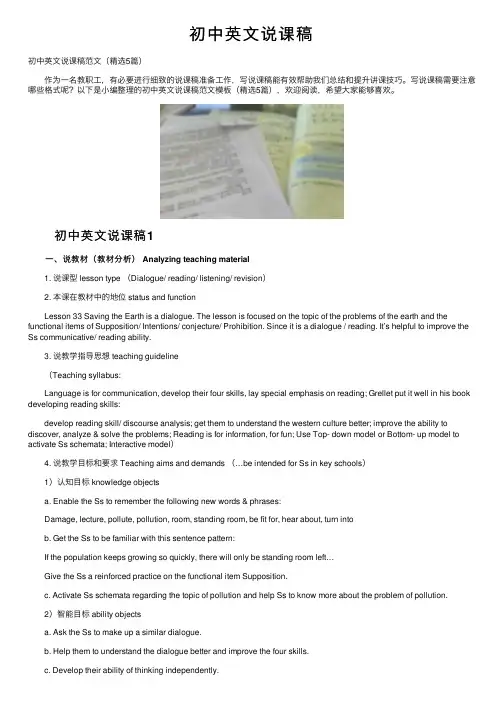
初中英⽂说课稿初中英⽂说课稿范⽂(精选5篇) 作为⼀名教职⼯,有必要进⾏细致的说课稿准备⼯作,写说课稿能有效帮助我们总结和提升讲课技巧。
写说课稿需要注意哪些格式呢?以下是⼩编整理的初中英⽂说课稿范⽂模板(精选5篇),欢迎阅读,希望⼤家能够喜欢。
初中英⽂说课稿1 ⼀、说教材(教材分析) Analyzing teaching material 1. 说课型 lesson type (Dialogue/ reading/ listening/ revision) 2. 本课在教材中的地位 status and function Lesson 33 Saving the Earth is a dialogue. The lesson is focused on the topic of the problems of the earth and the functional items of Supposition/ Intentions/ conjecture/ Prohibition. Since it is a dialogue / reading. It’s helpful to improve the Ss communicative/ reading ability. 3. 说教学指导思想 teaching guideline (Teaching syllabus: Language is for communication, develop their four skills, lay special emphasis on reading; Grellet put it well in his book developing reading skills: develop reading skill/ discourse analysis; get them to understand the western culture better; improve the ability to discover, analyze & solve the problems; Reading is for information, for fun; Use Top- down model or Bottom- up model to activate Ss schemata; Interactive model) 4. 说教学⽬标和要求 Teaching aims and demands (…be intended for Ss in key schools) 1)认知⽬标 knowledge objects a. Enable the Ss to remember the following new words & phrases: Damage, lecture, pollute, pollution, room, standing room, be fit for, hear about, turn into b. Get the Ss to be familiar with this sentence pattern: If the population keeps growing so quickly, there will only be standing room left… Give the Ss a reinforced practice on the functional item Supposition. c. Activate Ss schemata regarding the topic of pollution and help Ss to know more about the problem of pollution. 2)智能⽬标 ability objects a. Ask the Ss to make up a similar dialogue. b. Help them to understand the dialogue better and improve the four skills. c. Develop their ability of thinking independently. d. Cultivate their ability to discover, analyze and solve problems. e. Train them to collect information from the Internet. f. Train them with some effective learning methods to optimize Ss’ learning results. 3)德育⽬标 moral objects a. Arouse their interest in learning English; b. Help them to understand the background of pollution. c. Enable the students to love our earth and the nature. d. Be aware of the importance of stopping pollution & protecting our environment. e. Encourage the Ss to do something to save the earth. 5. 说教学重点 teaching important points (⽣词、句型;培养阅读技能) a. New words and phrases b. Sentence pattern: If- clause c. improve their reading skills. d. Talking about problems of the Earth. 6. 说教学难点 teaching difficult points (语法;发展交际能⼒) a. functional item: Supposition. b. Develop their communicative ability. Act out their own dialogue. 7. 说教具 teaching aids (multi-media computer, software, OHP) The teaching syllabus says that it’s necessary for teachers to use modern teaching facilities. It’s of great help to increase the class density and improve our teaching result. It can also make the Ss reach a better understanding of the text by making the classes lively and interesting. At the same time, it arouses the Ss’ interest in learning English. ⼆、说教法 Teaching methods Five step method; audio-video; communicative approach; Task-based learning: New Syllabus Design encourages teachers to use this teaching method. TBLT can stimulate Ss’ initiative in learning and develop their ability in language application. Make the Ss the real masters in class while the teacher himself acts as the director and bring their ability into full play. 三、说学法 Study methods 1. Teach Ss how to be successful language learners. 2. Teach Ss how to develop the reading skill — skim & scan; how to communicate with others; how to learn new words; how to learn independently; 3. Get the Ss to form good learning habits. 四、说教学过程Teaching procedures I. 复习(Revision) 5min (Daily report; 词汇diagram; brainstorming; activate schemata) Activity 1: Imagination 1) Suppose a bottle of ink is turned over and dirties your white shirt, what is to be done? (Wash it? Or throw it away?) 2) Suppose you catch a bad cold, what’s to be done? 3) Suppose your bike is broken, what’s to be done? 4) And suppose the earth, on which we all live, is damaged, what’s to be done? * What can you think of when you see "pollution" this word?(waste, environment, air, water, factory, desert, climate…Try to activate the Ss schemata regarding the topic of pollution.) II. 呈现(Presentation) 5min Activity 2: Presentation Play the song "Earth Song" sung by Michael Jackson. (Create an atmosphere) A lot of pictures and video clips about the causes and results of the three problems mentioned in this lesson will be shown on the screen with the help of the computer. Ss’ presentation on pollution. Attract their attention, arouse their interest, and create a good atmosphere for communication. * Activate their schemata and cultivate their ability in collecting information from the Internet and develop their ability in thinking independently. III. 对话 / 阅读(Dialogue)18m 1. Pre- reading Activity 3: Prediction 1st listening/ fast reading, one guided Q to help Ss to get the main idea: What do you think is discussed at the conference? 2. While- reading Activity 4: Read and answer 2nd listening/ careful reading, more Qs to get the detailed information. Develop their reading skills: skim & scan. Pay attention to the pronunciation, stress & intonation. * 阅读: Pre-reading; while-reading; post-reading (fast reading/ careful reading; skim/ scan; 识别关键词key words;确定主题句;创设信息差information gap;T or F; 填表格chart/diagram; Predicting; Make a timeline; Make a story map.达到对课⽂的`整体理解和掌握。
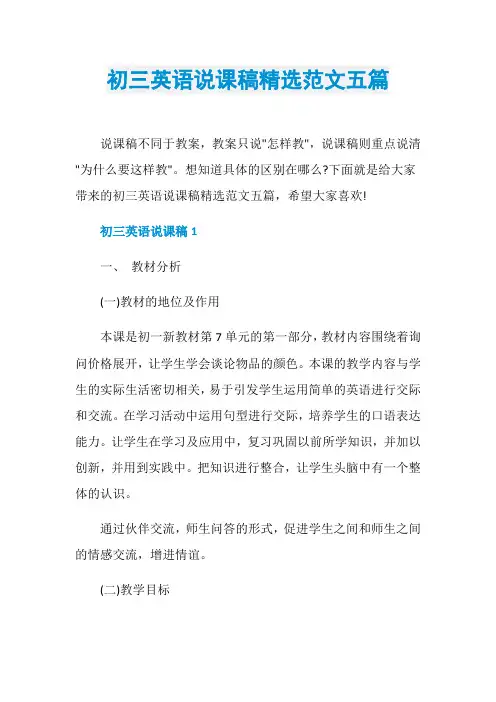
初三英语说课稿精选范文五篇说课稿不同于教案,教案只说"怎样教",说课稿则重点说清"为什么要这样教"。
想知道具体的区别在哪么?下面就是给大家带来的初三英语说课稿精选范文五篇,希望大家喜欢!初三英语说课稿1一、教材分析(一)教材的地位及作用本课是初一新教材第7单元的第一部分,教材内容围绕着询问价格展开,让学生学会谈论物品的颜色。
本课的教学内容与学生的实际生活密切相关,易于引发学生运用简单的英语进行交际和交流。
在学习活动中运用句型进行交际,培养学生的口语表达能力。
让学生在学习及应用中,复习巩固以前所学知识,并加以创新,并用到实践中。
把知识进行整合,让学生头脑中有一个整体的认识。
通过伙伴交流,师生问答的形式,促进学生之间和师生之间的情感交流,增进情谊。
(二)教学目标教学目标Aim 记忆物品pants , socks , T-shirt , shirt , shorts , sweater , shoes理解颜色理解:color , black , white , red , green , blue ,应用通过布置任务,让学生在合作中进行语言交流。
德育培养学生的合作精神,以及通过任务完成,学习勤俭节约的品德。
情感激发学生学习英语的兴趣,使学生获得成就感,增强自信心。
(三)教学重点及难点重点Importance Learn to ask about prices . 学习询问物品价格。
难点Difficulty Learn to talk about clothing . 学习谈论衣物,例如颜色、大小等。
活动中运用的单词、句型。
二、教法渗透本课主要运用“任务型教学法”,采用多媒体教学,并辅助于TPR(全身反映教学法)、情景交际教学法和游戏活动。
1、任务型语言教学法任务型语言教学是交际语言教学近年来发展起来的一种教学方法,主张采用任务型语言教学的人认为:人们使用语言的过程就是一个完成各种各样任务的过程。
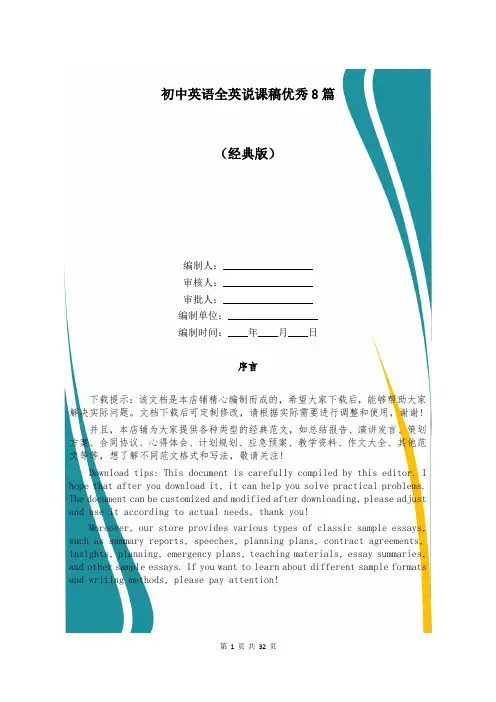
初中英语全英说课稿优秀8篇(经典版)编制人:__________________审核人:__________________审批人:__________________编制单位:__________________编制时间:____年____月____日序言下载提示:该文档是本店铺精心编制而成的,希望大家下载后,能够帮助大家解决实际问题。
文档下载后可定制修改,请根据实际需要进行调整和使用,谢谢!并且,本店铺为大家提供各种类型的经典范文,如总结报告、演讲发言、策划方案、合同协议、心得体会、计划规划、应急预案、教学资料、作文大全、其他范文等等,想了解不同范文格式和写法,敬请关注!Download tips: This document is carefully compiled by this editor. I hope that after you download it, it can help you solve practical problems. The document can be customized and modified after downloading, please adjust and use it according to actual needs, thank you!Moreover, our store provides various types of classic sample essays, such as summary reports, speeches, planning plans, contract agreements, insights, planning, emergency plans, teaching materials, essay summaries, and other sample essays. If you want to learn about different sample formats and writing methods, please pay attention!初中英语全英说课稿优秀8篇说课活动分课前说课和课后说课两种形式,不论是课前说课还是课后说课上述内容必须阐述清楚。
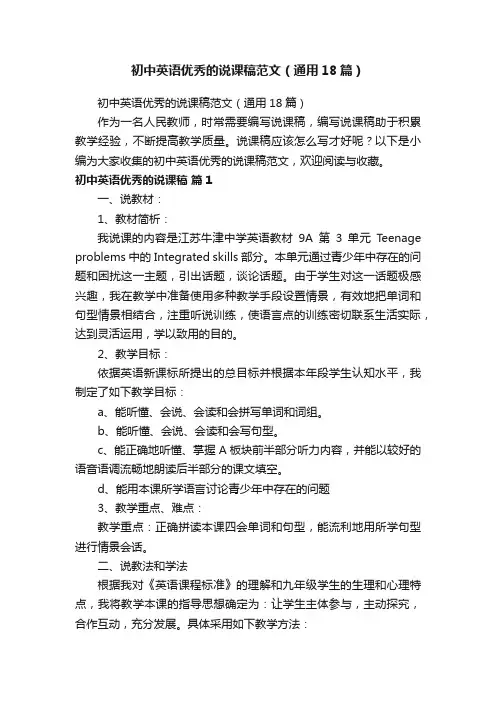
初中英语优秀的说课稿范文(通用18篇)初中英语优秀的说课稿范文(通用18篇)作为一名人民教师,时常需要编写说课稿,编写说课稿助于积累教学经验,不断提高教学质量。
说课稿应该怎么写才好呢?以下是小编为大家收集的初中英语优秀的说课稿范文,欢迎阅读与收藏。
初中英语优秀的说课稿篇1一、说教材:1、教材简析:我说课的内容是江苏牛津中学英语教材9A第3单元T eenage problems中的Integrated skills部分。
本单元通过青少年中存在的问题和困扰这一主题,引出话题,谈论话题。
由于学生对这一话题极感兴趣,我在教学中准备使用多种教学手段设置情景,有效地把单词和句型情景相结合,注重听说训练,使语言点的训练密切联系生活实际,达到灵活运用,学以致用的目的。
2、教学目标:依据英语新课标所提出的总目标并根据本年段学生认知水平,我制定了如下教学目标:a、能听懂、会说、会读和会拼写单词和词组。
b、能听懂、会说、会读和会写句型。
c、能正确地听懂、掌握A板块前半部分听力内容,并能以较好的语音语调流畅地朗读后半部分的课文填空。
d、能用本课所学语言讨论青少年中存在的问题3、教学重点、难点:教学重点:正确拼读本课四会单词和句型,能流利地用所学句型进行情景会话。
二、说教法和学法根据我对《英语课程标准》的理解和九年级学生的生理和心理特点,我将教学本课的指导思想确定为:让学生主体参与,主动探究,合作互动,充分发展。
具体采用如下教学方法:1、情景教学法:通过设置较为真实的情景,使学生产生身临其境的感觉,激起学生情感上的共鸣,从而引导学生从整体上理解和运用语言,促进学生的语言能力及情感、意志、想象力、创造力等整体发展。
2、小组学习法:每4人一组,可两两交流,也可自由选择,在互动中互相启发发生思维的碰撞。
同时注意保证每个学生都有机会参与学习,培养学生与伙伴合作的意识和策略,提高人际交往能力。
3、练习法:把大多课堂时间留给学生,使学生在多信息、高密度、快节奏的灵活操练中拓宽学习渠道。
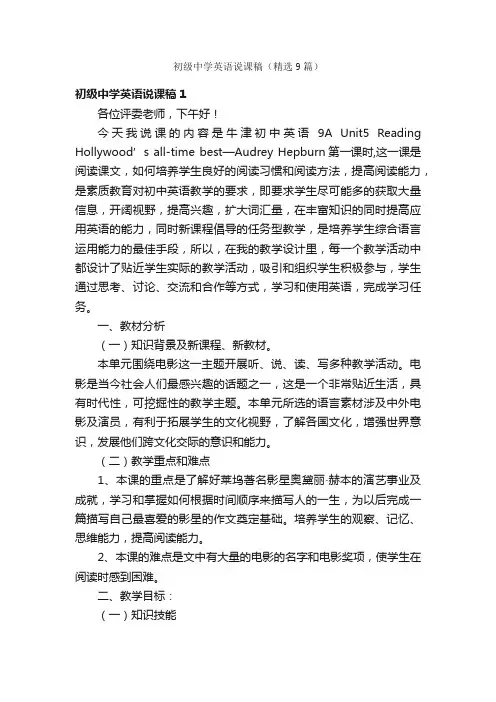
初级中学英语说课稿(精选9篇)初级中学英语说课稿1各位评委老师,下午好!今天我说课的内容是牛津初中英语9A Unit5 Reading Hollywood’s all-time best—Audrey Hepburn第一课时,这一课是阅读课文,如何培养学生良好的阅读习惯和阅读方法,提高阅读能力,是素质教育对初中英语教学的要求,即要求学生尽可能多的获取大量信息,开阔视野,提高兴趣,扩大词汇量,在丰富知识的同时提高应用英语的能力,同时新课程倡导的任务型教学,是培养学生综合语言运用能力的最佳手段,所以,在我的教学设计里,每一个教学活动中都设计了贴近学生实际的教学活动,吸引和组织学生积极参与,学生通过思考、讨论、交流和合作等方式,学习和使用英语,完成学习任务。
一、教材分析(一)知识背景及新课程、新教材。
本单元围绕电影这一主题开展听、说、读、写多种教学活动。
电影是当今社会人们最感兴趣的话题之一,这是一个非常贴近生活,具有时代性,可挖掘性的教学主题。
本单元所选的语言素材涉及中外电影及演员,有利于拓展学生的文化视野,了解各国文化,增强世界意识,发展他们跨文化交际的意识和能力。
(二)教学重点和难点1、本课的重点是了解好莱坞著名影星奥黛丽·赫本的演艺事业及成就,学习和掌握如何根据时间顺序来描写人的一生,为以后完成一篇描写自己最喜爱的影星的作文奠定基础。
培养学生的观察、记忆、思维能力,提高阅读能力。
2、本课的难点是文中有大量的电影的名字和电影奖项,使学生在阅读时感到困难。
二、教学目标:(一)知识技能1、了解好莱坞著名影星奥黛丽赫本的演艺事业及成就,学习和掌握如何根据时间顺序来描写人的一生,培养学生的观察、记忆、思维能力,提高阅读能力。
2、学习和掌握一些重要的单词、短语和句型。
如:effort enter industy French insist shortly immediately lifetime well-known throughout beyond devote honour present aloud not onl y…but also put her effort into during her lifetime devote to be honoured with pass away She began taking ballet lessons at a very young age. She had put most of her effort into ballet training before she entered the film industry, throughout her acting years, she acted in only one Tv series,… 等(二)情感态度1、从学生的学习兴趣出发,即想要迫切了解奥黛丽·赫本的演艺事业及成就,激发学生学习的积极性,增强学生综合运用语言的能力。
初中英语说课稿精选5篇初中英语说课稿篇一一。
指导思想新的课程标准强调课程从学生的学习兴趣、生活经验和认知水平出发,倡导体验、实践、参与、合作与交流的学习方式和任务型的教学途径,发展学生的综合语言运用能力,使语言学习的过程成为学生形成积极的情感态度、主动思维和大胆实践、提高跨文化意识和形成自主学习能力的过程。
通过对“新课标”的认真学习和深入领会,针对三年级学生的年龄特点及本课书的教学内容,我将课堂教学模式确定为“任务型与活动型相结合”的整体教学模式,在活动设计时本着体验学习、合作学习、思维学习的教学理念,将语言学习和多种能力的培养渗透到课堂活动和教学任务中,努力为孩子们提供一个不断感知、不断探索、不断提高的成长空间。
二。
说教材1.教材分析:本节课是PEP小学英语三年级上册第二单元B部分中的Lets learn和Lets do 的内容,其中Lets learn部分是在A部分Lets learn中blue, green, yellow, red词汇学习的基础上,再学习white, black, orange, brown这几个词汇的。
并围绕本课新授单词,穿插一些TPR 活动,即本课的第二部分Lets do,如Black, black. Stand up.等一些简单的指示语,要求学生听懂并按照指令做出相应的动作,同时鼓励学生滚动已学指令,如:sit down,touch the ground,turn around.并自创个人喜欢的新口令。
如:Black, black.Sit down. Black, the ground. Black, black.Turn around.等等。
学生能举一反三,以此达到语言教学的真正目的。
另外本课的词汇贴近学生的生活,色彩鲜明的图片与词汇配对,使学生更易理解,TPR活动更是深受儿童喜爱,所用的节奏和动作刺激大脑皮层,激活记忆,使学生在对各指令的反应中自然习得语言。
2.学情分析:在学习本节课前,学生已学了blue, green, yellow, red这几个颜色单词,学生对于色彩这方面内容较感兴趣,因此在前节课词汇学习的基础上,再学习white, black, orange, brown这些新单词,最后利用chant,给学生提供一个有趣、轻松、活泼的氛围去操练单词,学生更易理解,学得更快。
初中英语说课稿(优秀4篇)初中英语说课稿篇一一、说教材1、教材的地位和作用本课是人教版七年级英语上册第三单元第一课时。
本单元是就第二单元认知物体之后学习用英语认知人,而与学生最为熟悉的人就是家庭成员。
从“Is this your eraser? ”很自然过渡到“Is this your sister?”以前学的“What is this?”转变成“Who is this?”教材以This is my sister.为中心话题,围绕谈论有关家庭成员的用语,并学会询问别人的情况,介绍自己的家庭,谈论自己的情感。
但本单元生词较多。
出现在第一课时的就有十五、六个,同时还要认识到名词复数的概念及其运用。
因此,本课时任务比较艰巨。
2、教学目标结合新课程标准和大纲提出的基础教育阶段英语课程的总体目标以及本单元的教学内容我将本课教学目标设计如下:(1)、知识目标帮助学生学会、掌握单元单词;使学生对复数形式有初步了解;使学生掌握介绍他人的句型。
(2)、能力目标通过本节课学习,学生就家庭成员相互之间能用英语简单的介绍、询问、交流。
掌握基本This is/That is.。
. These are/Those are.。
. 等句型,培养学生实际交际的能力。
同时基本上能辨别什么时候用单数什么时候用复数。
(3)、情感目标通过介绍家人和朋友,学生对自己的家庭成员会有更清晰的印象,对学生进行亲情教育,从而激发起他们对家人的热爱。
3、教学重点及难点结合教学目标的要求和学生的特点,我把本课的重难点设置为:重点:熟练掌握各家庭成员的名称,理解外国文化中介绍家庭成员的方式。
这个单元最主要的就是学习家庭成员英语的表达,而几乎所有的单词都集中在第一课时。
所以这课时学会掌握这些单词应该是重中之重。
难点:复数的认识和正确运用。
汉语表达中完全没有复数概念,这是一本书,这是三本书;除了数字的改变没有其他任何变化。
而英语必须这样说This is a book. These are books.所有的单词都相应的发生了变化。
初中英语说课稿初中英语说课稿范文(通用5篇)作为一名辛苦耕耘的教育工作者,通常需要用到说课稿来辅助教学,说课稿有助于提高教师的语言表达能力。
那么大家知道正规的说课稿是怎么写的吗?以下是小编为大家整理的初中英语说课稿范文(通用5篇),欢迎阅读,希望大家能够喜欢。
初中英语说课稿1一、说教材(一)教材分析本单元出自山东教育出版社义务教育课程标准试验教科书八年级上册,第七单元在本册中处于教学的后期位置,但具有重要作用,重点在于培养学生英语交际能力,并结合生活中切实常用的话题:给人们的日常行为提出一定的建议,做出礼貌的道歉行为来展开基本语言内容的教学,并与第八单元的内容具有一定的联系。
本单元遵循教材总体特点,采用任务型教学模式,并融汇话题,交际功能和语言结构would you mind doing sth? 进而形成一套循序渐进的生活化的学习程序。
学生比较容易乐于接受,说课的内容是本单元Section A (1a~1c)部分,本课是单元首篇,以Would you mind turning down the music? 为主题,本节内容具有词汇量较大,强调综合运用,贴近生活实际等特点。
通过本节学习,可增加学生的单词储备量,提高学生综合运用能力,学生将学会用英文表达请求,表示歉意。
在获取基础知识,发展基本能力的同时进一步强化学生学以致言,学以致用的英语学习观和合作品质。
(二)教学目标依据并结合新课程标准提出的基础教育阶段英语课程的总体目标和具体要求,我将本课教学目标设计如下:知识目标:让学生掌握其中的重要词汇mind, turn down, not at all等和句式would you mind doing sth? 并能让学生掌握如何运用所学句式提出礼貌请求以及礼貌的向他人道歉。
能力目标:培养学生的听说读写能力,尤其是与他人用英语进行日常会话的能力。
情感态度目标:在本课教学中注重培养学生的礼貌行为,了解英语国家中向他人提出要求及道歉的方式,并通过小组活动,培养学生乐于学习并与他人合作的精神。
初中英语说课稿初中英语的说课稿优秀8篇作为一位兢兢业业的人民教师,有必要进行细致的说课稿准备工作,说课稿有助于提高教师的语言表达能力。
本页是敬业的小编帮大家收集的8篇初中英语的说课稿,欢迎参考阅读。
初中英语说课稿篇一(一)教材的地位及作用本课是初一新教材第5单元的一部分,教材内容围绕着描述人现在的活动展开,让学生学会谈论人人们正在干什么。
本课的教学内容与学生的实际生活密切相关,易于引发学生运用简单的英语进行交际和交流。
在学习活动中,学生能通过交换对不同人物活动的描述,促进学生之间和师生之间的情感交流,增进情谊。
(二)教学目标1、知识目标:What are you doing? I am watching.What is he doing? He is doing homework.Is she reading? No, she is doing her homework.2、能力目标:(1)、能抓住人物的主要特征来描述人物的外貌,并根据描述画出人像。
(2)、能概括人物的外貌特征并根据人物特征推理出某一人物。
3、情感目标:通过描述同学、教师或自己的偶像的外貌,表达自己的看法,使学生在人际交往中学会尊重和理解别人,学会交换不同的看法,了解他人的爱好,增进情谊。
(三)教学重点及难点1、掌握并运用描述人物活动和地点的词汇:watching, doing, eating cleaning, playing, reading, swimming, shopping, pool, school, mall, library2、掌握并运用简单的英语交际句型:What are you doing? I am watching.What is he doing? He is doing homework.Is she reading? No, she is doing her homework.(四)教法设计对本课我主要采取了如下几种教法:1.听录音。
初中英语教学说课稿(通用5篇)学校英语教学说课稿(精选篇2)一、教材分析本单元的核心教学项目是“谈论现在的状况”(Talking about the present),整个教学内容主要围绕“正在干什么”这个话题绽开,以此为语言背景,让同学通过4个课时的学习感知,初步把握本单元的语法项目--现在进行时的用法。
本单元的一个突出特点是:功能项目与语法项目是的统一的。
功能项目是用现在进行时来描述,它的语法项目是以功能项目为依托的。
前一单元的学习运用Can情态动词时,同学复习把握了大量的动词词汇为本单元同学把握进行时打下了良好的基础。
本课是本单元的第四课,它是本单元的复习课没有新的语法要点。
但它通过问答,对话表演及阅读等活动,巩固同学运用现在进行时表达实际需要的技能,换句话说,本课虽然是复习课,但我认为编者的意图不仅仅是让我们把它定位在复习巩固的要求上,而是盼望通过这一课,使同学能把本单元的功能项目与语法项目达到真正的统一,从而达到学以至用,培育用英语进行交际的力量。
在运用英语的过程中把握英语。
二、依据教材的前后联系和意图以及英语课程标准的要求,我认为本课的教学目标是:1、语言学问:把握单词Wear及Clear把握句型:I’m wearing…运用现在进行时。
2、语言技能:培育听说读写力量,尤其是说的力量,能与他人沟通信息,合作完成任务,并能运用现在进行时独立表达个人思想观点,为将来的写作打下良好的基础。
3、情感态度:通过一系列好玩的活动与任务,激发并强化同学的学习爱好,引导他们渐渐将爱好转化为稳定的学习动机,在教学中给以大量的信息沟,让同学产生剧烈的学习愿望,乐观主动地真实地投入到学习中去。
4、学习策略:通过任务型的教学,让同学学会自主学习,归纳总结,培育主动学习的力量。
尤其对所学内容能主动复习并加以整理和归纳的力量。
5、文化意识:通过一些国外校内生活的图片来了解外国同学的生活。
开拓同学的视野,并加以对比,从而培育同学的跨文化意识。
初中英语优秀说课稿初中英语优秀说课稿(5篇)作为一名优秀的教育工作者,时常需要用到说课稿,说课稿有利于教学水平的提高,有助于教研活动的开展。
那么写说课稿需要注意哪些问题呢?下面是小编为大家整理的初中英语优秀说课稿,仅供参考,大家一起来看看吧。
初中英语优秀说课稿1一、教材分析(一)教材的地位和作用基础教育阶段英语课程的任务是:激发和培养学生学习英语的兴趣,使学生树立自信心,养成良好的学习习惯和形成有效的学习策略,发展自主学习的能力和合作精神,使学生掌握一定的英语基础知识和听、说、读、写技能,形成一定的综合运用语言的能力。
我选择的7B Unit4谈论的是amazing things,话题围绕我们身边各种各样令人惊讶的现象或事件展开,很容易引起学生的兴趣并激发学生去了解更多令人惊讶的事情,并且在了解的前提下提高交流的能力。
1. Comic strip & Welcome to the unit部分通过一部分不寻常的现象和事件,让学生使用正确的形容词来表达自己的感受和见解。
2. Reading部分给大家讲了个故事,学完故事后要求学生掌握文中的语言点并能清楚的复述。
3. Vocabulary部分要求学生使用be fond of, be crazy about, like, dislike等来表达不同的喜好。
4. Grammar部分讲解了一般过时的构成和用法,并要求学生能根据情境正确使用一般过去时谈论过去的事件。
5. Integrated skills部分帮助学生了解更多动物的知识,要求学生从听力材料中获取相关信息并用自己掌握的信息使相关文章的意思表达完整,要求学生对惊讶、诧异的话作出恰当的反应。
6. Pronunciation部分要求学生掌握‘-ed’结尾单词的三种发音并正确区分和准确读出。
7. Main task部分要求学生通过调查研究获得事件信息并根据材料完成相关写作。
8. Checkout部分设计了练习,让学生在练习中巩固词汇和语法,理清写作思路。